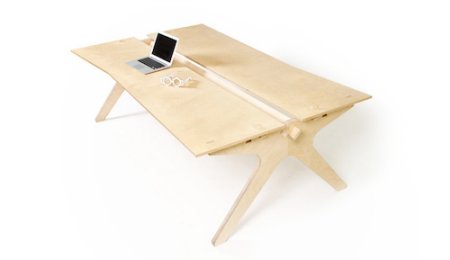Time:2015/5/8 9:18:04 Views:7756

The design for the original OpenDesk, which was made for Mint Digital, has been downloaded more than 1,200 times. Photo courtesy Opendesk
During a commission in 2011 for tech startup Mint Digital, architect Jonathan Steiner and his colleagues were trying to figure out how to make the same desk for both the client's London and New York offices. Shipping a large, multi-person piece of office furniture was not only cost prohibitive, but seemed awkward and inefficient. They came up with a high-tech solution; design a desk, save the plan as a digital file, then share the blueprint with a maker in Brooklyn who can build and fabricate it locally. That one-off project, and the insights that followed, led Steiner and his co-founders to create Opendesk, an open-source network that, via digital fabrication, connects designers, makers and buyers in a global marketplace of furniture creation and purchasing. They believe the platform can become a disruptive force that shakes up the furniture industry.
"You don't need to ship furniture," says Steiner. "Hardware becomes software becomes hardware again."
The Fin locker was originally designed for Greenpeace's London office. Photo courtesy Opendesk.
Calling from the company's London office, Steiner says the core concept is "open making" — the designer and maker get fairly treated and set their own terms, and the consumers get transparency and an informed choice.
After designers submit their ideas for plywood office furniture to Opendesk — Steiner says they're focusing on that market first, but plan to eventually expand into other arenas —they would then create either a .dwg or .dxf file, a standard that can be downloaded by furniture makers worldwide and realized utilizing a CNC machine (computerized numerical control). the design would then be available on the site for anybody to download, "print" and replicate. Currently, the model breaks down as follows: designers get 8-10 percent of the final price, Opendesk gets 15-20 percent and the rest goes to the fabricator, who has to pay for materials.
The Wiki Booth by Lynton Pepper provides privacy in a shared work environment. Photo courtesy Opendesk.
Steiner says this set-up allows Opendesk to be both disruptive and bespoke. By slightly altering an existing file, a custom piece of furniture can be built locally in 2-3 weeks, as opposed to a standard 6-8 week lead time. Since materials are sourced locally and the made-to-order finished pieces are shipped across town, not across the ocean, the system offers a more environmental alternative than standard furniture companies, bypassing the costly and inefficient storage and logistics chain. He points to the company's recent project for Greenpeace in London as an example of the platform's green potential. The non-profit liked being able to meet the local fabricators and have a say in the material sourcing, down to the content of the wood glues.
With more than 12,000 downloads, the original desk design for Mint Digital has found its way into quite a few offices. Steiner says the goal now is to scale up and expand the marketplace, which currently has 400 registered makers and dozens of designs, and find ways to deliver on the promise of open making and local production. Inside the office, a particular John Maynard Keynes quote has become a bit of a mantra for the company.
"It's easier to ship recipes than cakes and biscuits."